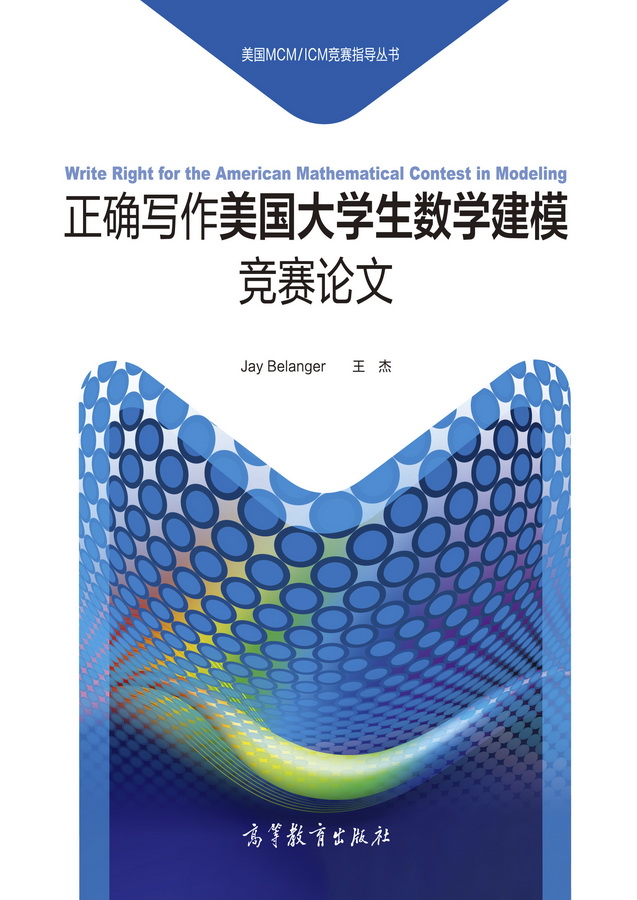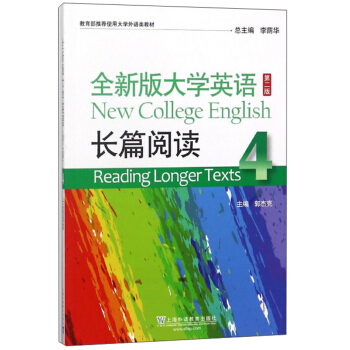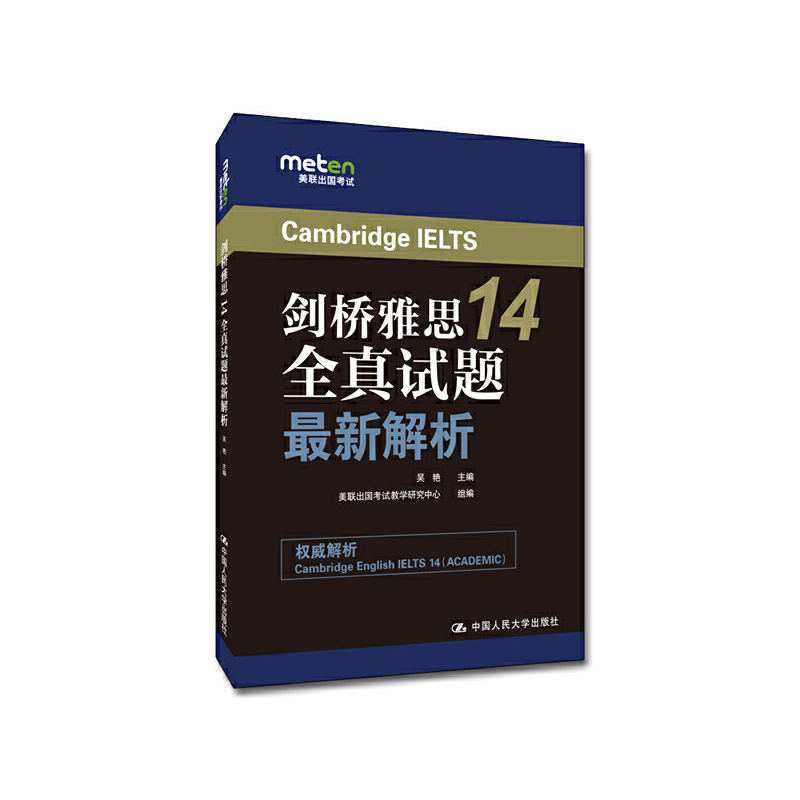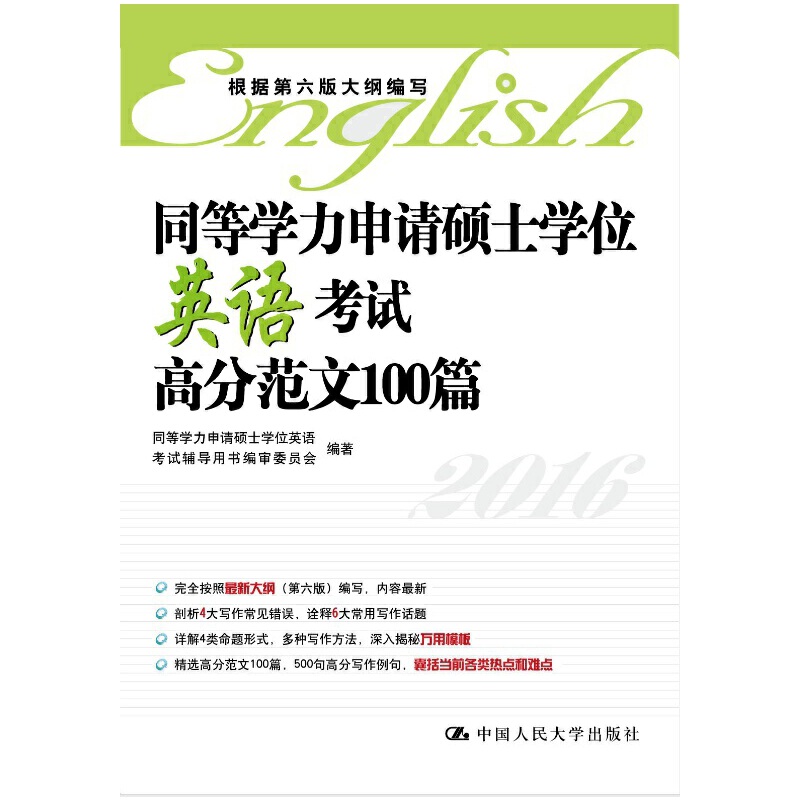正确写作美国大学生数学建模竞赛论文
作者: Jay Belanger 王杰
出版时间:2013-01-18
出版社:高等教育出版社
- 高等教育出版社
- 9787040340143
- 1
- 242147
- 平装
- 16开
- 2013-01-18
- 270
- 206
本书讨论如何正确写作美国大学生数学建模竞赛论文。书中包括两部分内容:一部分是地道的英文内容,另一部分是与之对应的中文介绍,这样的安排有助于读者先了解关键知识点,然后逐步培养用英文写作及思考的习惯。主要内容包括:论文结构、写作规范、英语用法、论文修改示例、符号与图表、数学表达式和句子以及数学编辑软件和MathType等。书中以中国学生提交的竞赛论文为案例,对常见错误进行了点评。
本书可作为指导大学生学习和准备美国大学生数学建模竞赛的主讲教材,也可作为大学生、研究生学习和准备全国大学生、研究生数学建模竞赛的参考书,也可供写作英文科技论文参考使用。
前辅文
I正确写作美国大学生数学建模竞赛论文
第1章 简介
1 简史
2 论文评审
3 写作的重要性
第2章 论文结构
1 小节划分
2 写好引言
3 论文主体
4 如何写结论
5 写好摘要
第3章 写作规范
1 使用第一人称复数代词
2 使用简单时态
3 使用主动语态
4 写简单的句子
5 写简短的段落
6 使用有具体含义的词汇
7 不含琐碎细节
8 突出重点
9 删掉多余词汇
10 使用并列短语强调相似性
11 避免单调重复
12 不使用同一词汇描述不同的对象
13 代词所指的名词必须清楚
14 不过分渲染
第4章 英语用法
1 保持主谓一致
2 正确使用that和which
3 避免拼写错误
4 用无争议的代词
5 正确使用冠词(the,a及an)
6 常用动词
第5章 论文修改示例
1 示例:如何修改标题
2 示例:如何修改摘要
3 示例:如何修改引言
4 示例:如何修改假设条件
第6章 符号与图表
1 选择合适的字体与字号
2 不在论文标题中使用数学符号
3 符号的常规用法
4 避免一符多用
5 不用符号取代文字
6 用文字书写作为形容词的数字
7 避免不必要的上下标
8 保持符号一致
9 保持下标顺序一致
10 删除只用过一次的符号
11 图形和表格
第7章 数学表达式和句子
1 不用数学符号作为句子的开头
2 句中多次出现的同一符号读法要一致
3 标点符号与阅读的连贯性
4 用文字分隔相邻的表达式
5 以文字叙述为主
6 不要超负荷使用同一词汇
7 每一个if都应该与一个then匹配
8 提供必要的提示
9 术语应该在即将使用时定义
10 如何排列数学表达式
11 如何书写分数
12 数学表达式的断行与对齐
13 省略号的对齐
第8章 \LaTeX
1 编译
2 简单示例
3 字符
4 数学表达式
5 定义新指令
6 页眉
7 论文标题与小节
8 脚注
9 列表
10 图形
11 表格
12 参考文献
13 文档结构样例
第9章 MathType
1 分数及平方根
2 积分、下标、求和
3 多重方程式
4 矩阵与行列式
5 在工具栏中存储表达式
6 对齐表达式
7 更改字体
8 表达式编号
9 Word文档的设置
10 常用字体
11 使用技巧
I IWrite Right for the American Mathematical Contest in Modeling
Chapter1 Introduction
1 A brief history
2 Classifications and judging
3 Writing is important
Chapter2 Paper Structure
1 Good structure goes a long way
2 Writing the introduction
3 The body of the paper
4 Writing a conclusion
5 Writing the summary
Chapter3 Style
1 Write in the first person, plural
2 Use the present tense
3 Use the active voice
4 Use simple sentences
5 Use short paragraphs
6 Use words which are as specific as you can
7 Do not include trivialities
8 Highlight important statements
9 Omit needless words
10 Use parallel phrasing to emphasize similarities
11 Avoid pointless repetition
12 Avoid using the same word for different purposes
13 Keep the antecedents of any pronouns clear
14 Do not overstate your results
Chapter4 English Usage
1 Make sure your subject and verb agree
2 Use ``that'' and ``which'' correctly
3 Use correct spelling
4 Use unobtrusive pronouns
5 Use articles (``the'', ``a'' and ``an'') properly
6 Useful verbs
Chapter5 Revising
1 Example: Revising a title
2 Example: Revising a summary
3 Example: Revising an introduction
4 Example: Revising assumptions
Chapter6 Symbols and Figures
1 Typography
2 Avoid using symbols in titles
3 Stick with notational and typographical conventions
4 Do not reuse symbols
5 Do not use symbols for words
6 Spell out numbers that are used as adjectives
7 Avoid unnecessary subscripts
8 Be consistent with your notation and terminology
9 Keep subscripts in the same order
10 Remove symbols that are used only once
11 Figures and tables
Chapter7 Math and Sentences
1 Do not begin a sentence with a symbol
2 Make sure the same symbol is always read the same
3 Punctuation and coherence
4 Separate different formulas with words
5 Use simple English
6 Do not overload math terms
7 Every ``if'' should have a ``then''
8 Give the reader useful reminders
9 Define terms right before you use them
10 Use displayed equations appropriately
11 Make your fractions readable
12 Watch your breaks and alignment in expressions
13 Align your ellipsis properly
Chapter8 \LaTeX
1 Compiling
2 A very basic document
3 Characters
4 Mathematics
5 New commands
6 The header
7 Title and sections
8 Footnotes
9 Lists
10 Figures
11 Tables
12 Bibliography
13 Sample file structure
Chapter9 MathType
1 Fractions and square root
2 Integrals, subscripts, and summations
3 Multiple equations
4 Matrices and determinants
5 Saving user-created expressions in the tabbed bar
6 Alignment
7 Change fonts and styles
8 Numbering equations
9 Word document settings
10 Default fonts and styles
11 Tips
附录 参赛须知
1 注册
2 竞赛和赛题
3 可用资源
4 竞赛结束前
5 竞赛结束后
参考文献



















